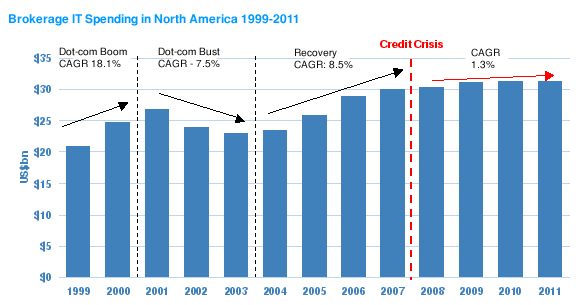Brokerage IT Spending and Priorities: Finding a Way Through Lean Times
Abstract
The cyclical nature of broker-dealer IT expenditure is once again in the spotlight as the credit crisis is set to pull large brokerages down for another several quarters. Celent projects that brokerage IT spending in North America for 2008-2011 will move forward at a tepid CAGR of 1.3%, down significantly from a CAGR of 8.5% during the previous cycle.
In a new report, , Celent examines brokerage IT spending, including both short-term and long-term IT priorities, and how IT vendors can position themselves in this more difficult environment. The report looks in detail at the current weakened situation at brokers and the resulting shifts in technological priorities at both Tier 1 and Tier 2 firms.
Originally seen as a minor bump in the road, the credit crisis has now resulted in three consecutive quarters of writedowns reaching almost US$150 billion. According to Oliver Wyman, there is more to come, as projections show that continued softening of the markets is likely to persist for at least another six quarters. Based on historical data, brokerage IT spending and headcounts have been correspondingly cut when times are bad, and boosted when times are good. Mitigating factors in this cyclical relationship are the specificity of markets directly affected and the growing strategic alignment of IT within business units.
"The trend seems to be that the closer the firms are to the subprime flame, the bigger and possibly longer the IT spending priority adjustments," says Chermaine Lee, analyst with Celent's Securities & Investments group and co-author of the report.
Although brokerage IT priorities seem clear in the long run, the current market and economic volatility have been a cause for concern among CIOs and business unit managers. To combat the expected hit on revenue and profits, brokerages are adjusting their technological priorities in the short run. Areas like risk management, compliance, and portfolio valuation continue to be high on the IT list. Moreover, while brokerages have long been bolstering their front office execution capabilities, recent attention appears to be shifting to back and middle office operational efficiency projects rather than growth plans.
"In line with moderate expectations for growth and a decreased appetite for grandiose IT projects, operational efficiency and cost-reducing initiatives will be the centerpiece of many brokerage firms’ IT plans," says David Easthope, senior analyst with Celent's Securities & Investments group and co-author of the report.
Despite the weakened environment, however, long-term IT priorities remain largely the same. With IT becoming more of a strategic driver, technological priorities tend to be more recession-proof. However, to be well positioned for the short and long term, IT vendors will have to meet the sell side’s needs for cost-efficient and flexible services and systems in these lean times.

This 38-page report contains 14 figures and 10 tables. A table of contents is available online.
Members of Celent's Institutional Securities & Investments research service can download the report electronically by clicking on the icon to the left. Non-members should contact info@celent.com for more information.

